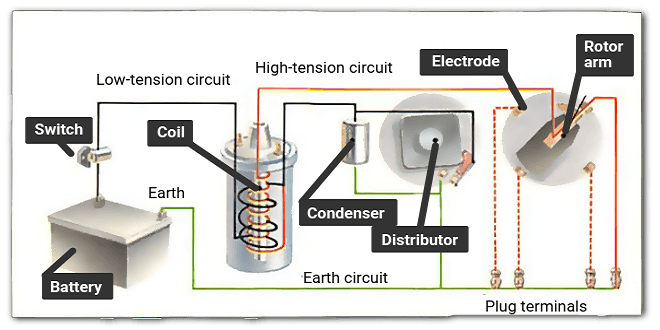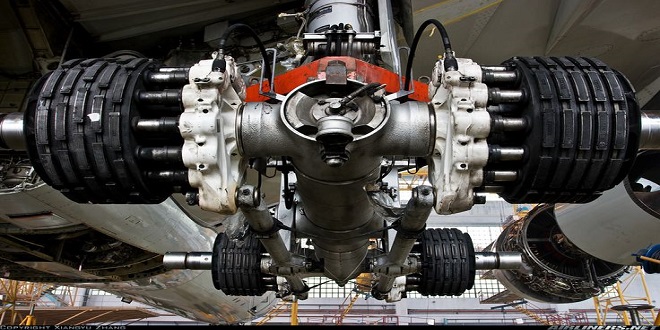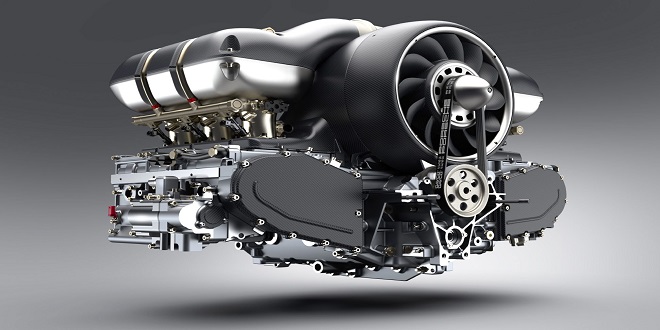Ignition systems – Ignition fundamentals

Functional requirements
The fundamental purpose of the ignition system is to supply a spark inside the cylinder, near the end of the compression stroke, to ignite the compressed charge of air-fuel vapor. For a spark to jump across an air gap of 0.6 mm under normal atmospheric conditions (1 bar), a voltage of 2–3 kV is required. For a spark to jump across a similar gap in an engine cylinder, having a compression ratio of 8: 1, approximately 8 kV is required.
For higher compression ratios and weaker mixtures, a voltage up to 20 kV may be necessary. The ignition system has to transform the normal battery voltage of 12 V to approximately 8–20 kV and, in addition, has to deliver this high voltage to the right cylinder, at the right time. Some ignition systems will supply up to 40 kV to the spark plugs.
Generation of high tension
If two coils (known as the primary and secondary) are wound onto the same iron core then any change in magnetism of one coil will induce a voltage into the other. This happens when a current is switched on and off to the primary coil. If the number of turns of wire on the secondary coil is more than the primary, a higher voltage can be produced. This is called transformer action and is the principle of the ignition coil.
Advance angle (timing)
For optimum efficiency, the ignition advance angle should be such as to cause the maximum combustion pressure to occur about 10 ° after top dead center (TDC).
Fuel consumption and exhaust emissions
The ignition timing has a significant effect on fuel consumption, torque, drivability and exhaust emissions. The three most important pollutants are hydrocarbons (HC), carbon monoxide (CO) and nitrogen oxides (NOx). The HC emissions increase as timing is advanced. NOx emissions also increase with advanced timing due to the higher combustion temperature. CO changes very little with timing and is mostly dependent on the air-fuel ratio.
As is the case with most alterations of this type, a change in timing to improve exhaust emissions will increase fuel consumption. With the leaner mixtures now prevalent, a larger advance is required to compensate for the slower burning rate. This will provide lower consumption and high torque but the mixture must be controlled accurately to provide the best compromise with regard to the emission problem.
Conventional ignition components – Spark plug
Seals electrodes for the spark to jump across in the cylinder. Must withstand very high voltages, pressures, and temperatures.
Ignition coil
Stores energy in the form of magnetism and delivers it to the distributor via the HT lead. Consists of primary and secondary windings.
Ignition switch
Provides driver control of the ignition system and is usually also used to cause the starter to crank.
Ballast resistor
Shorted out during the starting phase to cause a more powerful spark. Also contributes toward improving the spark at higher speeds.
Vacuum advance
Changes timing depending on engine load. In conventional systems, the vacuum advance is most important during cruise conditions.
Last word
Delphi produces a variety of cable types that meet the increased energy needs of leaner-burning engines without emitting electromagnetic interference (EMI). The cable products offer metallic and non-metallic cores, including composite, high-temperature resistive, and wire-wound inductive cores. Conductor construction includes copper, stainless steel, Delcore, CHT, and wire-wound. Jacketing materials include organic and inorganic compounds, such as CPE, EPDM, and silicone.





